<<back
Sanitation Teething Problems of Basic Household Wastewater and Sewage Treatment Outdated Approaches
Prepared by: Prof. Dr. P.M. Sivalingam,
Country Director IRDCA,
Consultant – UN & UNEP
21st April 2007
Most developing countries encounter numerous problems regarding wastewater due to its technological economic constrain along with the ever pressing needs for rapid development. As a consequence, it can be assumed that 95 percent of household wastewater, including sewer, is discharged wantonly without even consorting to primary treatment into adjacent natural water bodies regarding them as nature’s perpetual cleansing reservoir, which is evidently otherwise. An explicit example was the occurrence of the cholera epidemic some years back in Penang on 10th May 1996 due to the breakage of a sewer pipe contaminating the water supply of the Island culminating in an epidemic with Penang topping the list (1,017 cases) followed by Kedah (131), Perak (47), Terengganu (12), Selangor (10), Kelantan (8), Kuala Lumpur (4) and Negri Sembilan (1). A similar incident also occurred in Laguna, Manila, on 9th June 1996 resulting in 1 death and 75 falling ill.
Bearing this in mind, and taking into consideration of an area located in the vicinity of the outdated Penang’s Jelutong Ocean Outfall system (until lately), investigations had indicated that between 1988 – 1990 18% of typhoid, 20% of cholera and 14% of hepatitis cases in the Island were from this area. Race composition of these diseases reflected the following: - typhoid – 89% Chinese, 65% Malays and 5% Indians; cholera – 39% Chinese, 6% Malays and 55% Indians; and hepatitis – 80% Chinese, 10% Malays and 10% Indians, respectively, indirectly reflecting a close relationship with their dietary habits and awareness of the Jelutong Ocean Outfall system in their vicinity. Only 55% were aware of the existence of this Ocean Outfall system out of which 11% were Malays, 10% Indians and 79% Chinese. From this composition, 14% agreed to the possible negative effects of it, i.e., 14% Malays, 33% Indians and 53% Chinese. Similarly, another 57%, viz. 22% Malays, 20% Indians and 58% Chinese, were aware of the possible threats of this practice on health related problems without awareness of specific issues. It obviously transpires evidence of such above-mentioned diseases due to fishing and recreational habits in the surrounding waters.
Taking into consideration of the high distribution of microbes in the discharged sewage, investigations carried out on the adjacent bottom ooze sediments, finfish, oysters and mussels to identify the existence of viruses in them which included extra-cellular fluids and gills according to three size categories of the organisms, viz. small, medium and large, with the aid of SEM. Positive results were obtained indicating the infection of oysters and mussels by viruses and the prevalence of identical viruses in the adjacently discharged original sewage from the Jelutong Ocean Outfall system. These viral infections also varied with the classified age groups of the organisms and organelles, i.e. mitochondria and nucleus. The obtained results is discussed taking into consideration the numerous facets of problems that would be encountered with regard to mariculture of fin- and shellfish, environmental contamination, tourism and socio-economics within the context of improper wastewater treatment technology and sanitation.
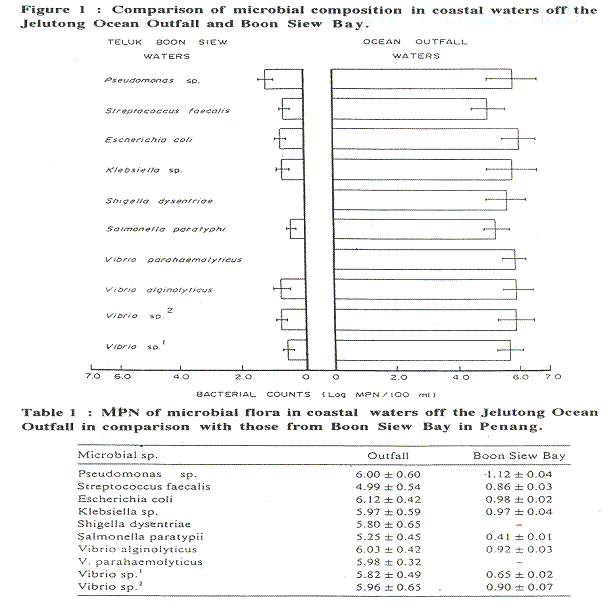
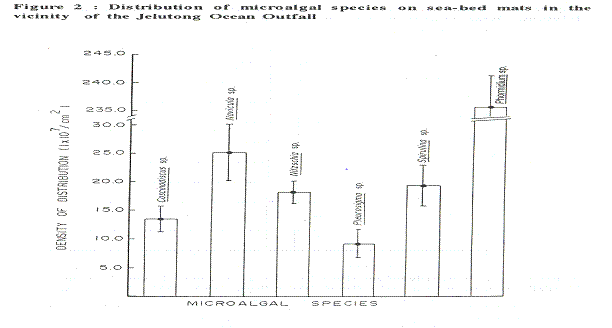
Level of microbial Contamination as a consequence of Raw Sewage Discharge into Adjacent Waters.
In the daily discharge of raw sewage amounting to ca. 14.4 x 107 gallons the microbial flora counts/100 cm3 are as follows:- coliform; 4.9 x 107, E. coli; 1.6 x107, total aerobic count; 1.3 x 108 and total spore formers; 2.3 x 103. The intensity of parasitic eggs/200 cm3 is: - Ascaris lumbricoides; 2,375, hookworms; 105, Trichurus trichura; 310, and Toxocara canis; 50. As a comparison of this discharge the adjacent waters of the locality of the Ocean Outfall ranged as follows: - with regard to coliform between 20,450 – 712,000 and E. coli 12,330 – 234,000. This on comparison to cleaner waters, i.e. 927 and 7 – 130, respectively, could be evaluated to be atrocious in warranting recreational and fishing activities. Detailed comparison of microbial flora distribution in cleaner waters (= Boon Siew Bay) with those in the vicinity of the Ocean Outfall are as indicated in Figure 1 and Table 1.
Sewage Microbial Flora Contamination on Marine Organisms.
-
Contamination on sea-bed algal-mat.
The high content of eutrophication factors, viz. nitrate; 12.39 ppm, NH3; 8.01 ppm and total – PO4; 2.32 ppm, facilitate the thriving of algal-mats on the sediment bed in the vicinity of the Ocean Outfall with the predominant species being Phormidium sp. followed by Navicula sp.> Spirulina sp.> Nitzschia sp. > Coscinodiscus sp.> Pleurosigma sp. This is evident in Figure 2. In relation to these sea-bed mats and their algal species distribution, evaluation of microbial flora distribution intensities transpired the following trend in E. coli > Aeromonas sp. & Klebsiella sp. > Pseudomonas sp. > Salmonella sp. > Vibrio sp.1 > Vibrio parahaemolyticus & Vibrio sp.2 (refer to Figure 3).
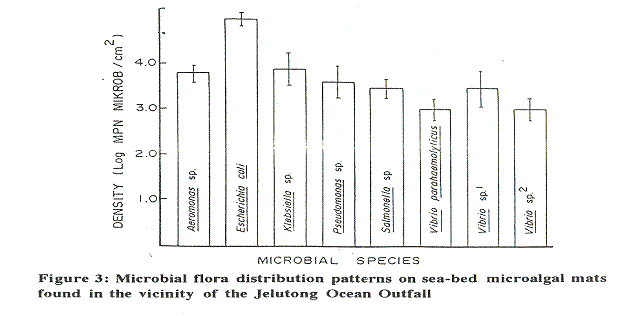
(b)Contamination in the rock oyster, Saccostrea cucullata BORN, in relation to age groups.
A comparison on the level of contamination by microbial flora in Saccostrea cucullata BORN harvested in the vicinity of the Ocean Outfall with those from waters of Boon Siew Bay indicated that the levels were much higher in those from the Ocean Outfall area and harbored an additional two species, viz. Vibrio parahaemolyticus and Corynebacterium sp. besides E. coli, Klebsiella sp., Vibrio sp., Pseudomonas sp., Neisiella sp. and Micrococcus sp. In oyster species from the Ocean Outfall and Boon Siew Bay areas, the bacterial counts were least in the age groups of 10.5 and 7.5 months, respectively, reflecting some influence of the intensity in contamination in the water medium as well as adaptation of the organisms in depuration processes. It might also have some connection with the physiology and related enzyme systems (refer to Figures 4 and 5).
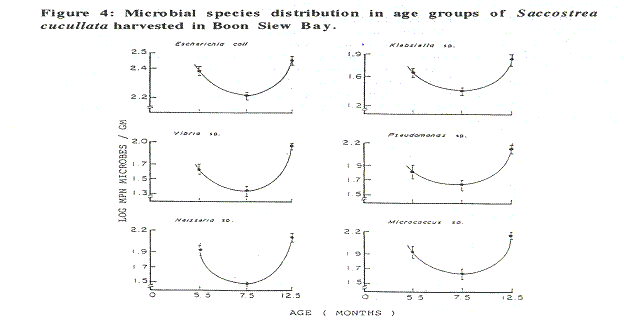
(c) Contamination in the green – mussel, Perna viridis Linnaeus, in relation to age groups.
On an identical basis, as already mentioned for the rock oyster, the microbial flora in Perna viridis Linnaeus harvested in the vicinity of the Ocean Outfall in comparison with those from Aling Bay (=close to Boon Siew Bay), on the contrary, indicated the existence of six species, viz. E.coli, Klebsiella sp., Pseudomonas sp., Neisseria sp., and Micrococcus sp. Nevertheless, the levels MPN in specimens obtained in the locality of the Ocean Outfall in general were two-folds higher (refer to Figures 6 & 7). The non-existence of other microbial species as detected in Saccostrea cucullata BORN probably has very much to do with the metabolic patterns of this bivalve in generating pseudofaeces.
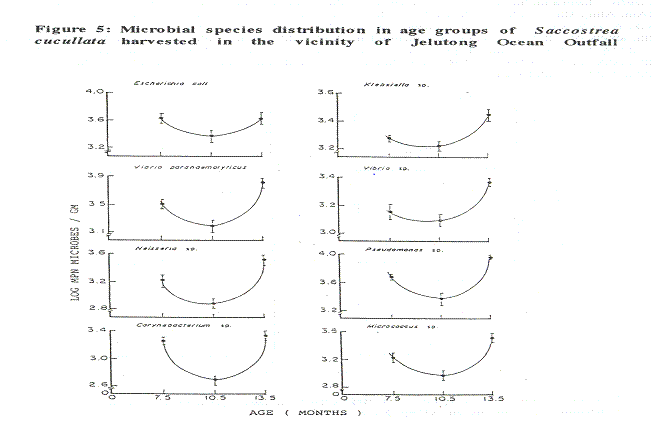
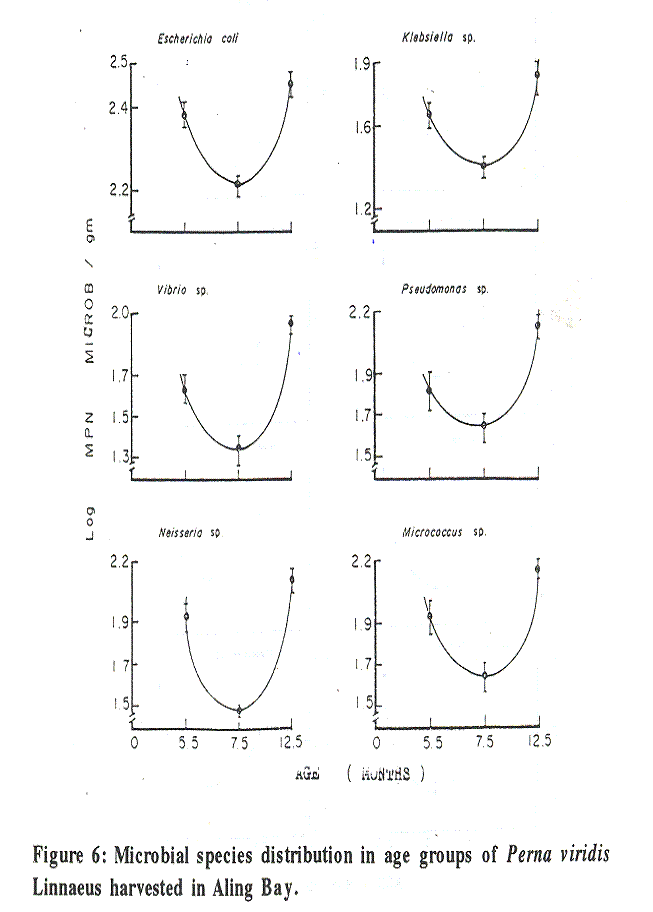
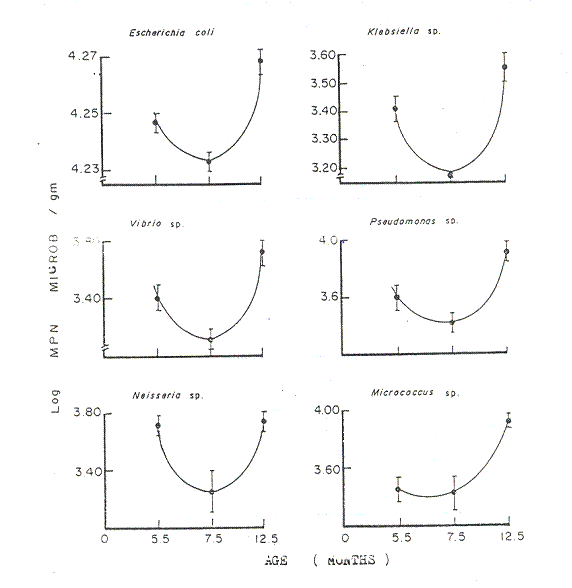
Figure 7: Microbial species distribution in age groups of Perna viridis Linnaeus harvested in the vicinity of the Ocean Outfall.
- Contamination in the finfish Liza dussumieri.
Investigations on the microbial flora contamination in skin, meat and intestines of the finfish Liza dussumieri found in the vicinity of the Ocean Outfall indicated varying intensities in distribution of 11 species of microbes in the intestine > skin > gills and none in the meat (refer to Figure 8). The microbes found in the intestines were E. coli, Micrococcus sp., Neisseria sp., Pseudomonas sp., Salmonella sp., Shigella sp., Streptococcus faecalis, Vibrio alginolyticus, Vibrio parahaemolyticus, Vibrio sp1 & Vibrio sp2. Micrococcus sp. and Streptococcus faecalis were not detected in the skin while Neisseria sp., Shigella sp., Vibrio parahaemolyticus, Vibrio sp.1 and sp.2 in the gills. If these finfish were consumed without proper removal of the intestines, skin & gills then probably health problems may surface.
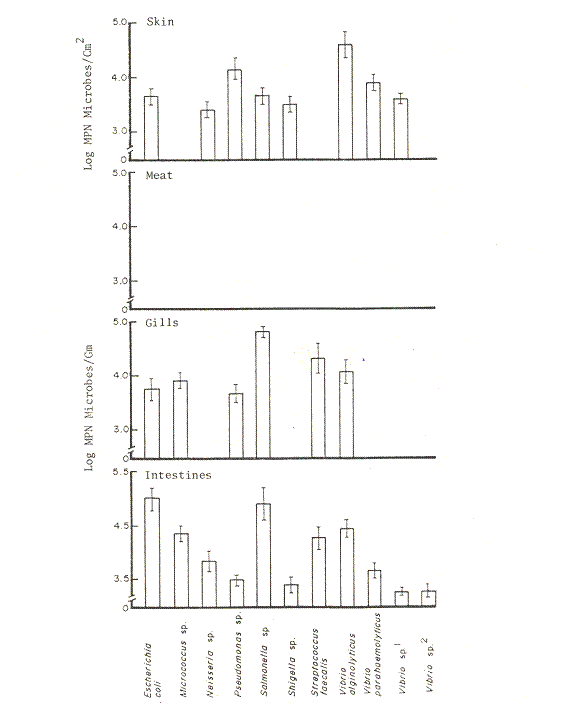
Figure 8: Microbial species distribution in skin, meat and intestines of the finfish Liza dussumieri harvested in the vicinity of the Ocean Outfall.
Sewage Viral Contamination in Marine Organisms.
Previously as already being indicated that as a consequence of raw sewage discharge in the Island, a number of health related problems had surfaced. To tangibly verify this point the raw sewage was subjected to centrifugal separation into sediments and supernatant at varying centrifugal forces. The separated fractions were scrutinized for the existence of viruses and it was ascertained that maximal sedimentation of it occurred at 8,000 rpm (refer to Figure 9). The morphological appearance of the virus is as illustrated in the following SEM micrograph (refer to Plate 1 at 4K).
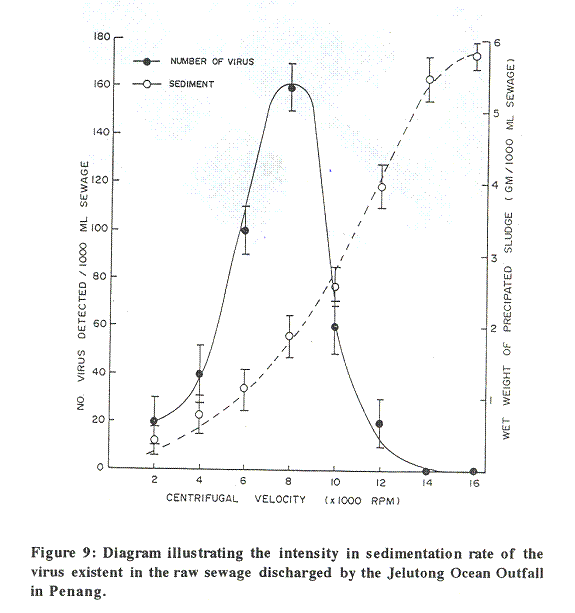
Plate 1: Micrograph of Isolated Virus Illustrating its Morphology.
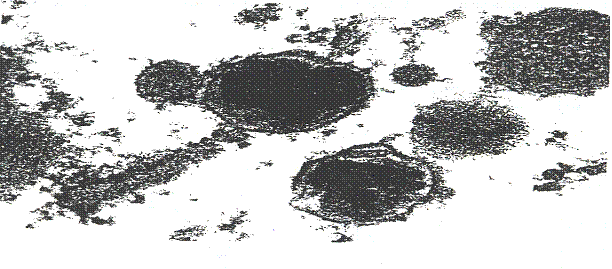
Viral Infection of gill cells according to age groups in the rock oyster Saccostrea cucullata BORN.
Viral infection was noticed in the gill cells of the rock oyster with the aid of SEM. The infection rates were highest in the small age groups (23 %) followed by the large (16 %) and medium age groups (9 %). This applied also to cellular mitochondria and nucleus attacks. Such attacks were greater in the mitochondria of both small and medium age groups while reverse in the larger age group (refer to Figure 10).
Viral infection of gill cells according to age groups in the green mussel, Perna viridis Linnaeus.
Viral infection in gill cells of the green mussel, Perna viridis Linnaeus, harvested in the vicinity of the Ocean Outfall reflected similar tendencies as observed for those of the rock oyster, Saccostrea cucullata BORN. Cellular infection was 25 % for the small age group followed by the large (17 %) and medium (13 %) age groups. Mitochondrial attack was highest in the small and medium age groups while being highest in the larger age group (refer to Figure 11).
Both the higher infections in the small and large age groups by the said virus and the reverse phenomenon in attacks on the nucleus in the large age group contrary to the mitochondria in the other age groups definitely reflect the fluctuating resistant mechanism intensities in them. The aforementioned information greatly tallies with related findings in the bivalves Thyasira goudi, Thyasira flexuosa, and T. sarsi in Western Scotland (Southward and Southward, 1991) leading to the decrease in their population. Similar observations were also noticed in clams and oysters from the Chesapeake Bay (Harshbarger et al., 1977), Tellina tenuis (da Costa) from other Scottish coast (Buchanan, 1978) and six species of Thyasiridae from North-east Atlantic region (Southward, 1986). Incidentally, these happenings have much to do with Ocean Outfall systems widely practiced in the U.K. and the USA.
Discussion
It is evident that wastewater treatment processes executed in the form of an Ocean Outfall system negates its prime objectives culminating to be evidently detrimental from all angles. One of the major consequences is its negative effects on human health while being concomitantly unwanting for aesthetic ventures and ultimately economic benefits. Hence, it is absolutely imperative, like most Asian countries, to endow greater emphasis on proper sewage treatment technology in order to sustain the pristine status of the ever deteriorating environment and water resources. If immediate appropriate and pertinent action/measures are not taken the repercussions on the tropical ecosystem/cum others would be so great and stressful that future endeavors to regenerate it would be exorbitantly costly and even more at times impossible. A food for thought for the State/local as well as the Federal governments.
References
Buchanan, J.S. 1978. Cytological studies on a new species of rikettisia found in
Association with a phage in the digestive gland of the marine bivalve mollusks,
Tellina tenuis (da Costa). Journal of Fish Diseases, 1: 27 – 43.
Harshbarger, J.C., Chang, S.C. and Otto, S.V. 1977. Chlamydiae (with Phages), Myco-
plasms, and Rickettsiae in Chesapeake Bay Bivalves. Science, 196: 666 – 668.
Southward, E.C. 1986. Gill symbionts in Thyasirids and other bivalve mollusks. J. Mar.
Biol. Ass. U.K.., 66: 889 – 914.
Southward, E.C. and Southward, A.J. 1991. Virus like particles in bacteria symbiotic in
Bivalve gills. J. mar. biol. Ass. U.K., 71 : 37 – 45.
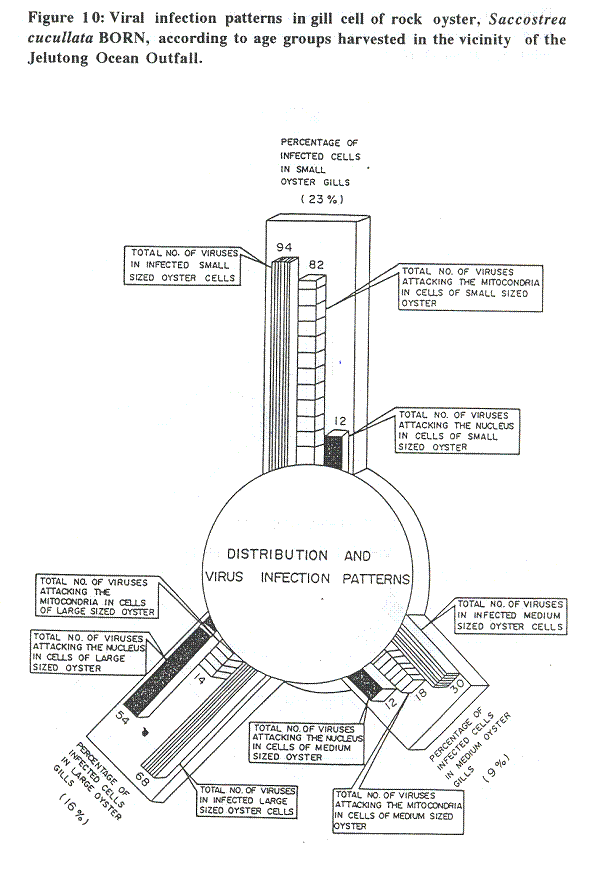
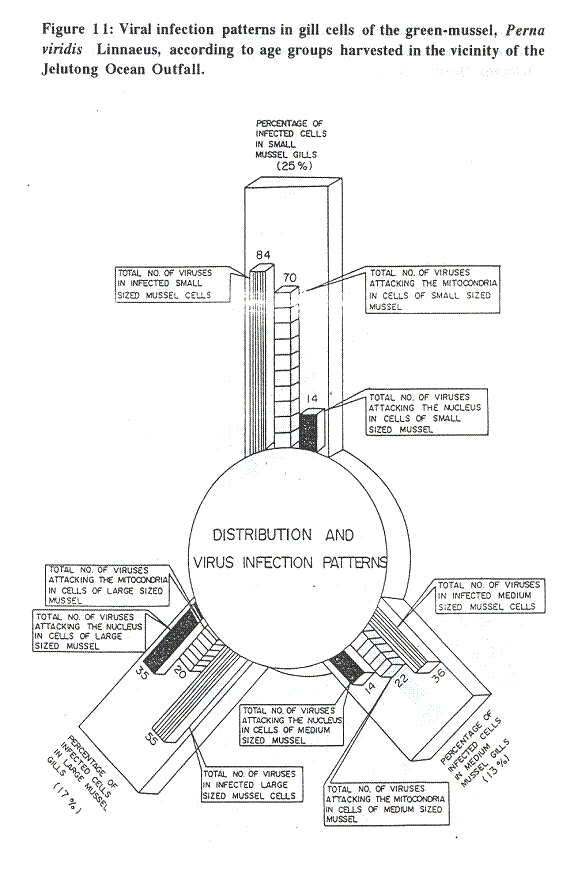
|











